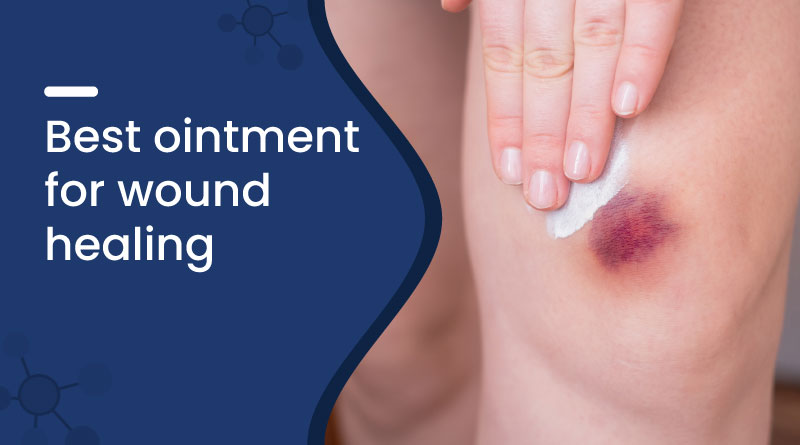Best Ointment For Wound Healing


Wounds are breaks in your skin. Cuts, scrapes, or burns cause them. They develop as tissue is damaged, exposing inner layers. Best ointments, often antibiotic or moisturizing, function by preventing infection, soothing, and creating a healing environment. They promote faster recovery, reduce scarring, and are generally safe when used as directed, aiding the body's natural repair process.
How do wounds form?
Wounds form when something damages your skin or body tissue. This can be from a sharp object cutting you, a fall causing a scrape, heat burning you, or even pressure. The injury breaks open the protective outer layer, exposing the inner parts.
How does ointment for wound healing work?
Ointments for wounds work by creating a protective, moist layer. This keeps germs out and prevents the wound from drying, which speeds up healing. Some also contain ingredients that fight infection or reduce pain, helping your skin repair itself smoothly.
Benefits of Ointment for Wound Healing:
- Prevents Infection: Ointments create a barrier, keeping harmful bacteria from entering the wound. This helps wounds heal cleanly.
- Keeps Wound Moist: A moist environment is crucial for healing. Ointments prevent drying, allowing cells to repair and new skin to form.
- Reduces Scarring: By keeping the wound hydrated and protected, ointments help minimize thick or noticeable scars.
- Soothes Pain/Discomfort: Many ointments offer a calming effect, reducing irritation, itching, and mild pain during healing.
How to Use Wound Healing Ointment?
- Wash your hands well first.
- Gently clean the wound.
- Apply a thin ointment layer.
- Cover with a bandage if needed.
- Reapply as directed, usually daily.
- Watch for signs of infection.
- Stop use if irritation occurs.
What Are the Best Ointments for Wound Healing?
| Product Name | Use |
|---|---|
| Mupicin Ointment | Topical antibiotic for treating skin infections and promoting wound healing. Effective against cuts, scrapes, and minor wounds. |
| Zevodine 5% Ointment | Antiseptic ointment with Povidone Iodine. Prevents infection in minor burns, cuts, and wounds. |
| Zosporin Skin Ointment | Antibiotic ointment for skin infections and open wounds. Helps in faster recovery by stopping bacterial growth. |
| Thromzee Ointment | Used to reduce swelling and bruising. Can help in wound-related inflammation and pain relief. |
When Will I Get Relief from My Wound?
Relief from discomfort often begins soon after using ointment, as it soothes and protects. However, complete healing takes days to weeks, depending on the wound's depth and care. Continue treatment until fully healed.
What Are the Steps Taken for Wound Healing?
- Stop the bleeding. Blood vessels narrow, and clots form to seal the wound.
- Clean the wound. The body’s cells clean up germs and debris.
- Build new tissue. New skin cells and blood vessels grow and fill the wound.
- Strengthen and reshape. The new tissue matures, forming a stronger scar.
When to Seek Medical Advice?
- The wound shows infection signs.
- Healing is not progressing.
- The wound is deep or large.
- Bleeding doesn't stop.
- Foreign objects are stuck inside.
- Pain worsens significantly.
- Develop a fever or chills.
- You have diabetes or weak immunity.
- The ointment causes any reaction.
What Are Home Remedies for Healing Wounds?
- Clean with mild soap and water.
- Apply honey topically.
- Use aloe vera gel.
- Keep the wound moist with petroleum jelly.
- Cover with a clean bandage.
- Elevate the injured area to reduce swelling.
- Proper rest helps your body heal.
- Eat a healthy diet to support recovery.
How to Select the Best Ointment for Wound Healing?
- Assess wound type: Minor cut, scrape, or serious injury.
- Consider infection risk: Antibiotic ointments help for open wounds.
- Prioritize moisture: Moisture aids faster and better healing.
- Check for allergies: Avoid ingredients that irritate your skin.
- Follow doctor's advice for serious wounds.
Which Is the Best Ointment for Wound Healing?
Best ointments keep wounds moist and fight germs. Some soothe irritation and protect your skin as it heals.
Zeelab Zevodine 5% Ointment and Mupicin Ointment are available at the best price. You can order the medicine online.
Conclusion
Untreated wounds can worsen quickly. The best ointments create a protective, moist environment that prevents infection and aids healing. Prevention involves immediate care and cleanliness. Awareness of proper treatment, choosing the right ointment, and knowing when to seek medical help ensures faster, safer recovery and minimizes scarring.
Frequently Asked Questions
Q: What is the best ointment for healing wounds fast?
A: There’s no single “best.” Keeping wounds clean and moist with a simple ointment helps them heal faster.
Q: Can I use antiseptic cream instead of an ointment?
A: Antiseptic cream kills germs. Ointment helps wounds stay moist and heal. Both help in different ways.
Q: Is it safe to use antibiotic ointments daily?
A: Yes, for minor cuts, daily use is generally safe. Don't overuse them.
Q: Which ointment is good for deep cuts or surgical wounds?
A: Deep cuts need a doctor. They may prescribe specialized ointments.
Q: Are there any herbal ointments for wound healing?
A: Yes, like aloe vera. But always consult a doctor first.
Q: Can I use petroleum jelly like Vaseline on wounds?
A: Yes, it keeps minor wounds moist and protected.
Q: How often should I apply wound ointment?
A: Usually 1 to 3 times daily. Follow product instructions or doctor’s advice.
Q: What ointment is best for burn wounds?
A: For minor burns, petroleum jelly helps. Severe burns need medical care.
Q: Can I use wound ointment on children?
A: Yes, many are safe for minor wounds in children. Read labels or ask a doctor.
Q: Are there any side effects of wound healing ointment?
A: Side effects are usually mild like itching or redness. Stop use and see a doctor if it worsens.
Related Products
Need Medicines Quick?
Share location to check quick delivery serviceability.
Change Location
Location Access Needed
Your location appears to be blocked or disabled.
Please enable the location from your browser or
device settings.

₹ 0
0
Items added
2025 Copyright By © Zeelab Pharmacy Private Limited. All Rights Reserved
Our Payment Partners

 Added!
Added!
|
|







